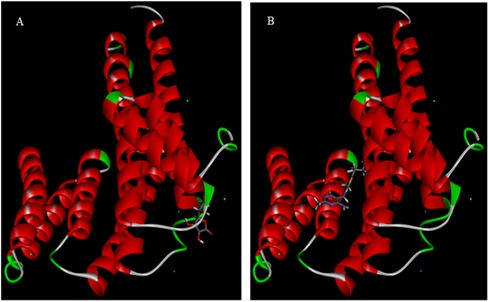Investigation of Phytoestrogens Found in Sesame Seeds via Computational and Translational Approaches
Abstract
 Abstract Views: 0
Abstract Views: 0
Polycystic Ovarian Syndrome (PCOS) is a common endocrine disorder that primarily impacts reproductive-aged women. Phytoestrogens, also known as plant oestrogens, are naturally occurring compounds with a chemical structure similar to that of human oestrogen. In this study, rational and translational approaches were used to check the efficacy of phytoestrogens found in sesame seeds. The objectives included the prediction and comparison of proteins responsible for PCOS, that is, MADH4 and phytoestrogens (ascorbic acid and thiamine) present in sesame seeds. Moreover, their interaction and inhibition of the target protein through molecular docking as a rational layout were recorded. The effects of these phytochemicals were further confirmed by using PCOS induced Sprague dawley rats with standard drug Clomiphene citrate. In the translational study, PCOS was induced in an animal model and ovulation and estrous cycles were observed. Afterwards, the effects of the crude extract of sesame seed were further confirmed by measuring the levels of progesterone, testosterone, and estrogen serum levels in control, positive control, and all the sesame seed and standard drug treated groups. Two lead compounds namely ascorbic acid and thiamine obtained from sesame seeds showed the best results as compared to the standard drug Clomiphene citrate which imparts immunotoxicity against MADH4 protein responsible for the onset of PCOS. Furthermore, different stages of ovulation namely proestrus, metestrus, estrus, and diestrus were observed with vaginal smears obtained in the disease induction time period. The results obtained from the hormonal profile of all the groups indicated that the progesterone, estrogen, and testosterone levels were statistically significant with p-values less than 0.05. The findings indicated that sesame seeds possess the capability to suppress the expression of MADH4, while also maintaining the regulated hormone levels.
Downloads
References
Khan MJ, Ullah A, Basit S. Genetic basis of polycystic ovary syndrome (PCOS): current perspectives. Appl Clinic Genet. 2019;12:249–260. https://doi.org/10.2147/TACG.S200341
Szczuko M, Kikut J, Szczuko U, et al. Nutrition strategy and lifestyle in polycystic ovary syndrome—narrative review. Nutrients. 2021;13(7):e2452. https://doi.org/10.3390/nu13072452
Ajmal N, Khan SZ, Shaikh R. Polycystic ovary syndrome (PCOS) and genetic predisposition: a review article. Eur J Obs Gynecol Reprod Biol. 2019;3:e100060. https://doi.org/10.1016/j.eurox.2019.100060
Panda PK, Rane R, Ravichandran R, Singh S, Panchal H. Genetics of PCOS: a systematic bioinformatics approach to unveil the proteins responsible for PCOS. Geno Data. 2016;8:52–60. https://doi.org/10.1016/j.gdata.2016.03.008
Kamenov Z, Gateva A. Inositols in PCOS. Molecules. 2020;25(23):e5566. https://doi.org/10.3390/molecules25235566
Khan MJ, Ullah A, Basit S. Genetic basis of polycystic ovary syndrome (PCOS): current perspectives. Appl Clinic Genet. 2019;12:249–260. https://doi.org/10.2147/tacg.s200341
Najafi MN, Ghazanfarpour M. Effect of phytoestrogens on sexual function in menopausal women: a systematic review and meta-analysis. Climacteric. 2018;21(5):437–445. https://doi.org/10.1080/13697137.2018.1472566
Lohmiller JJ, Swing SP. Reproduction and breeding. In: The Laboratory Rat. Elsevier; 2006:147–164.
Goldman JM, Murr AS, Cooper RL. The rodent estrous cycle: characterization of vaginal cytology and its utility in toxicological studies. Birth Defects Res B Dev Reprod Toxicol. 2007;80(2):84–97. https://doi.org/10.1002/bdrb.20106
Hebel R, Stromberg MW. Anatomy and Embryology of the Laboratory Rat. Wörthsee: BioMed Verlag; 1986.
King TL, Brucker MC. Pharmacology for Women’s Health. Burlington: Jones and Bartlett Publishers; 2010.
Marilyn R, Richardson MD. Current perspectives in polycystic ovary syndrome. Am Family Phys. 2003;68:697–705.
Bartolone L, Smedile G, Arcoraci V, Trimarchi F, Benvenga S. Extremely high levels of estradiol and testosterone in a case of polycystic ovarian syndrome. Hormone and clinical similarities with the phenotype of the alpha estrogen receptor null mice. J Endocrinol Invest. 2000;23(7):467–472. https://doi.org/10.1007/bf03343757
Wei P, Zhao F, Wang Z, et al. Sesame (Sesamum indicum L.): a comprehensive review of nutritional value, phytochemical composition, health benefits, development of food, and industrial applications. Nutrients. 2022;14(19):e4079. https://doi.org/10.3390/nu14194079
Baroroh U, Si S, Biotek M, Muscifa ZS, Destiarani W, Rohmatullah FG, Yusuf M. Molecular interaction analysis and visualization of protein-ligand docking using Biovia Discovery Studio Visualizer. Indo J Comput Biol. 2023;2(1):22. https://doi.org/10.24198/ijcb.v2i1.46322
Rostami M, Farzaneh V, Boujmehrani A, Mohammadi M, Bakhshabadi H. Optimizing the extraction process of sesame seed’s oil using response surface method on the industrial scale. Indust Crop Prod. 2014;58:160–165. https://doi.org/10.1016/j.indcrop.2014.04.015

Copyright (c) 2023 Sania Riaz

This work is licensed under a Creative Commons Attribution 4.0 International License.
BSR follows an open-access publishing policy and full text of all published articles is available free, immediately upon publication of an issue. The journal’s contents are published and distributed under the terms of the Creative Commons Attribution 4.0 International (CC-BY 4.0) license. Thus, the work submitted to the journal implies that it is original, unpublished work of the authors (neither published previously nor accepted/under consideration for publication elsewhere). On acceptance of a manuscript for publication, a corresponding author on the behalf of all co-authors of the manuscript will sign and submit a completed the Copyright and Author Consent Form.








